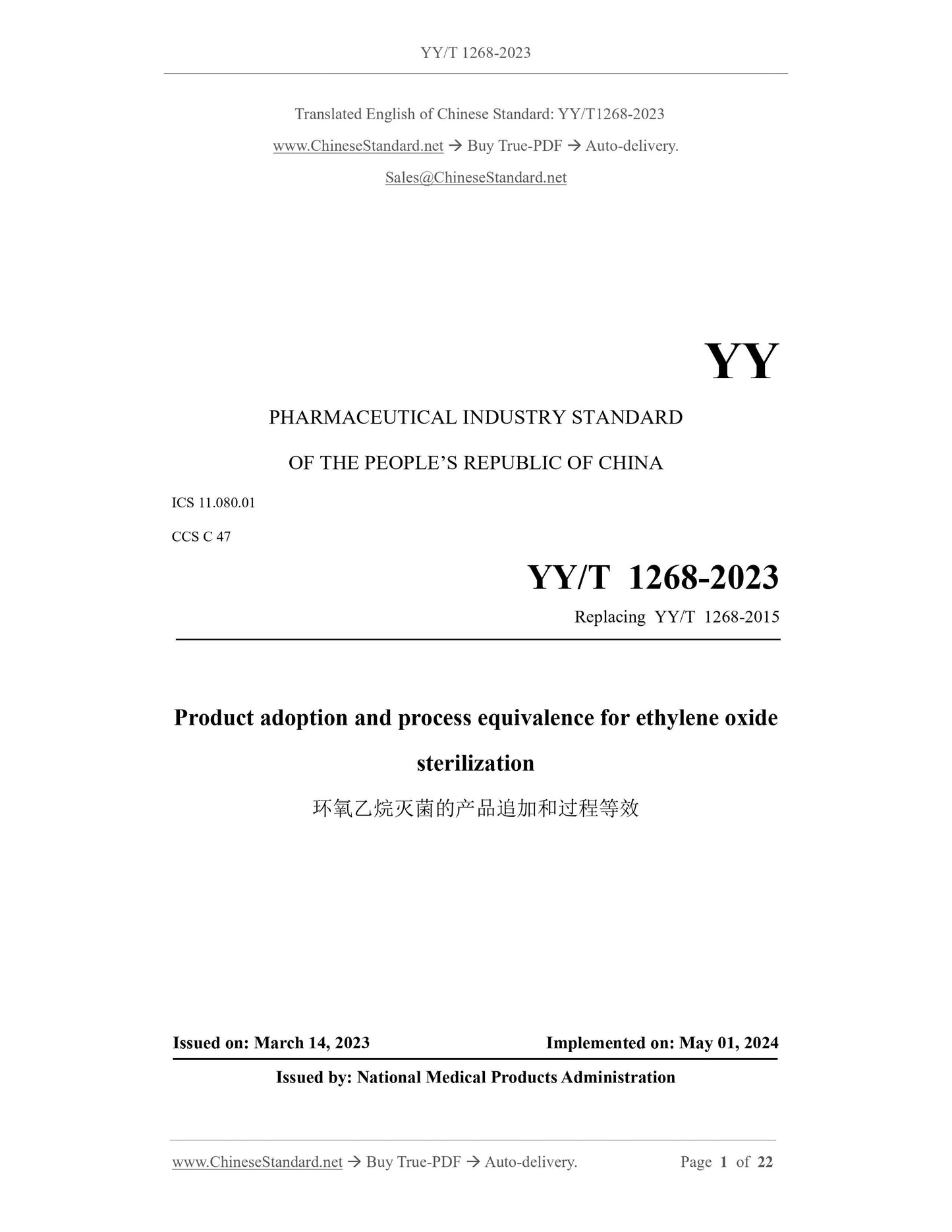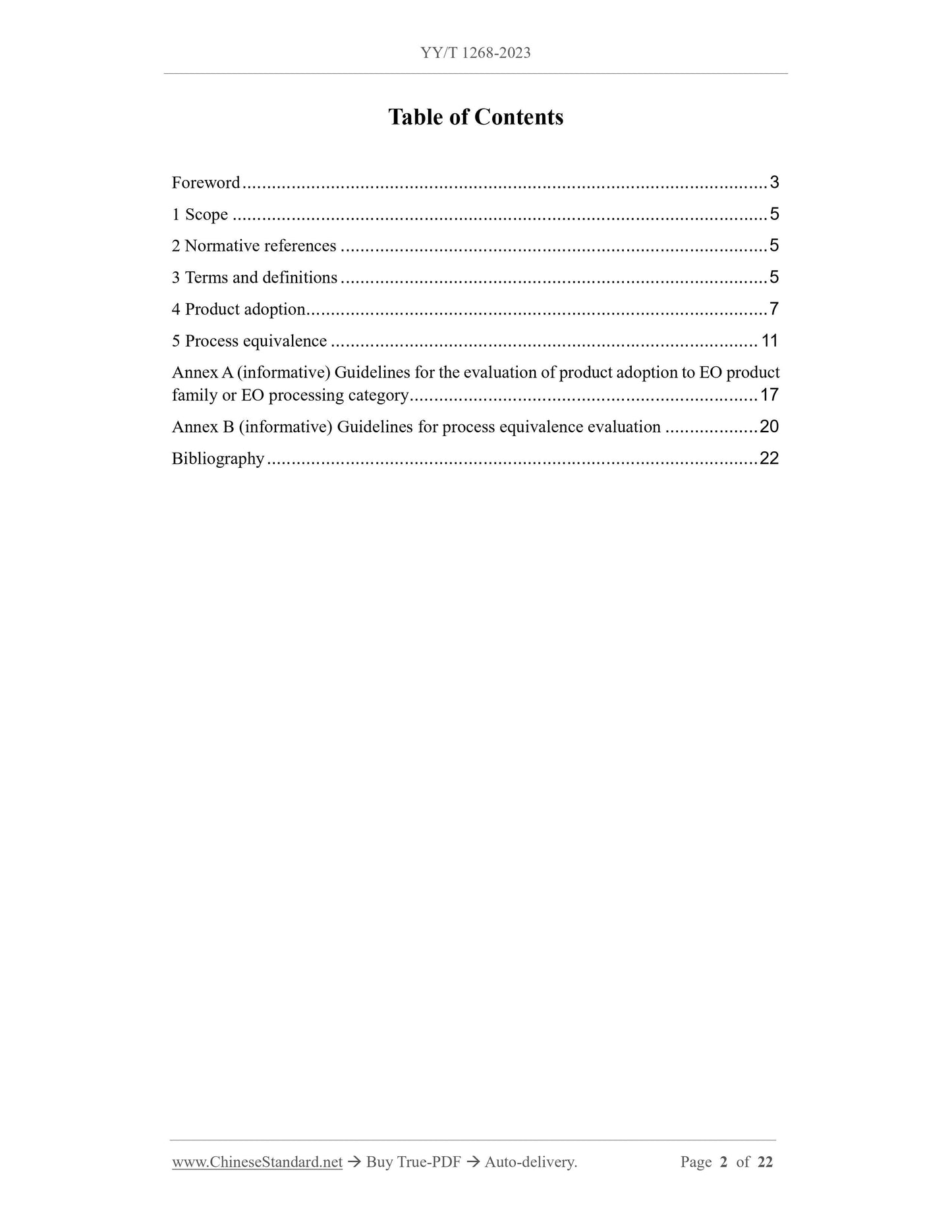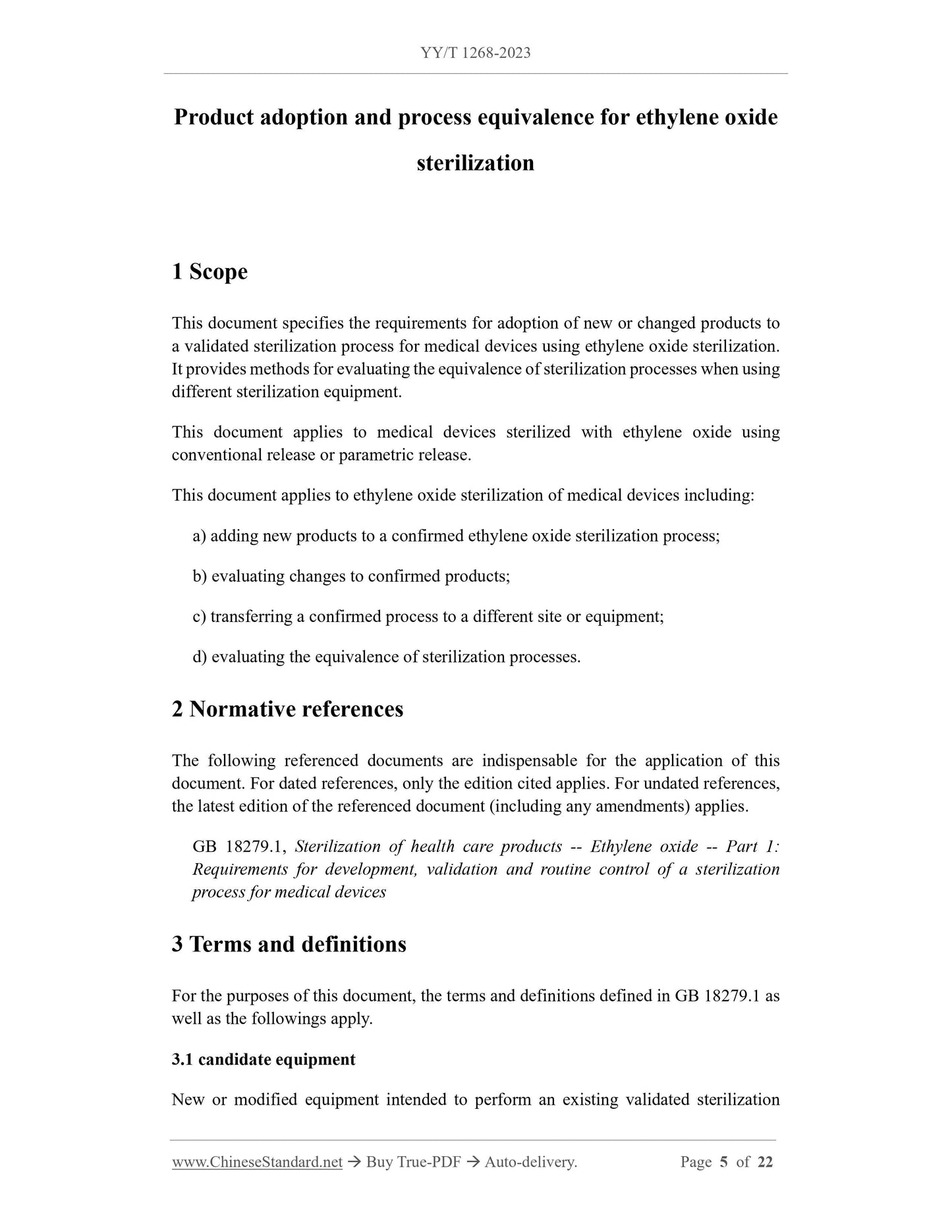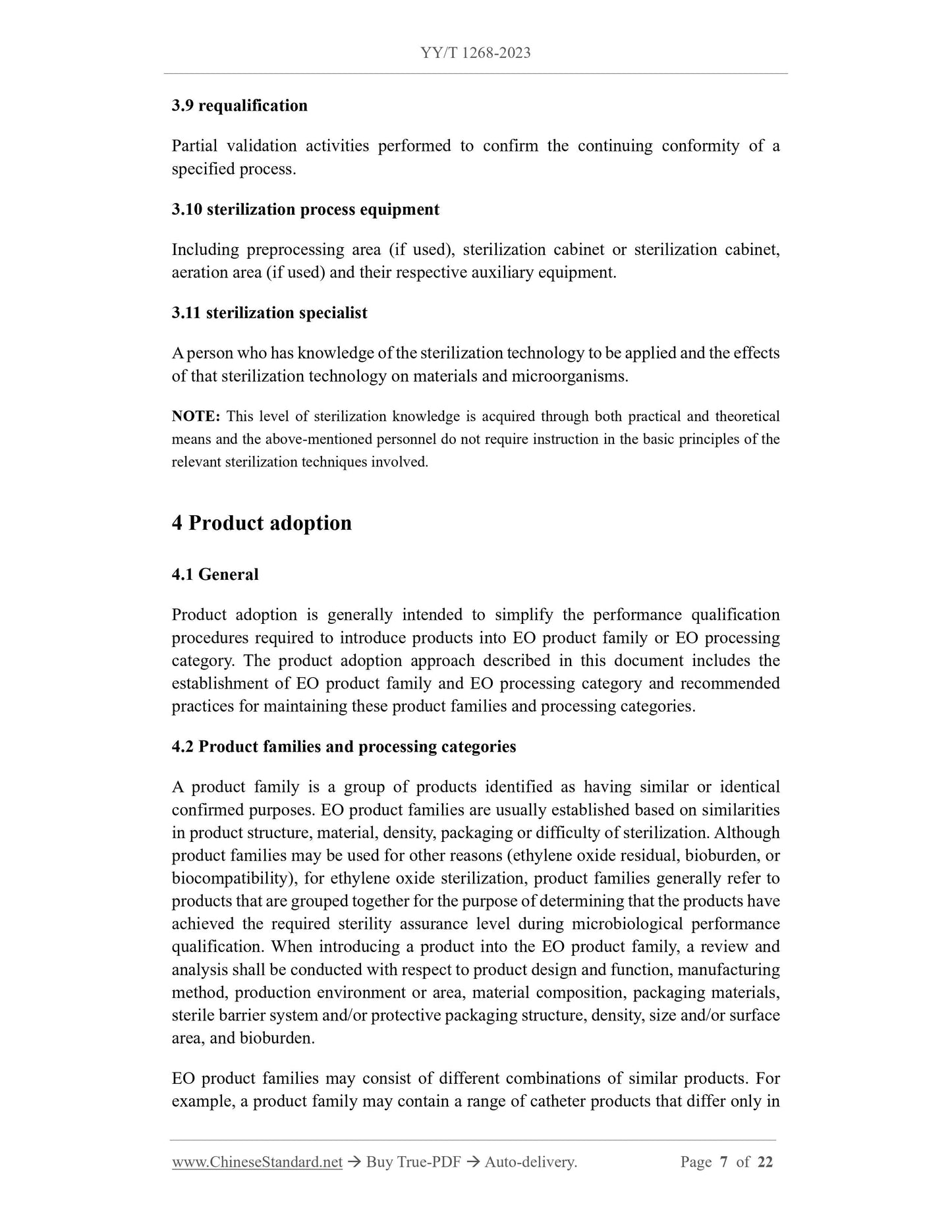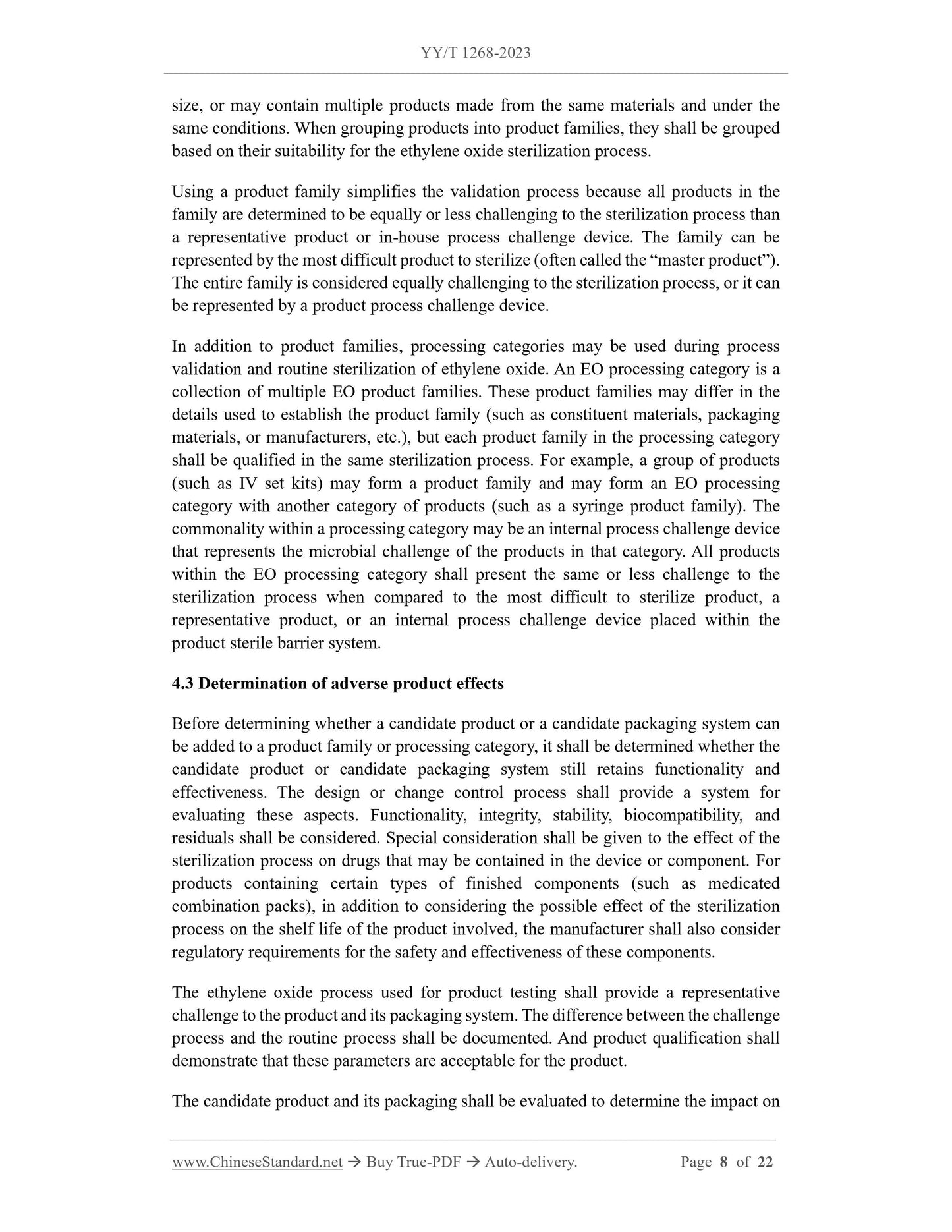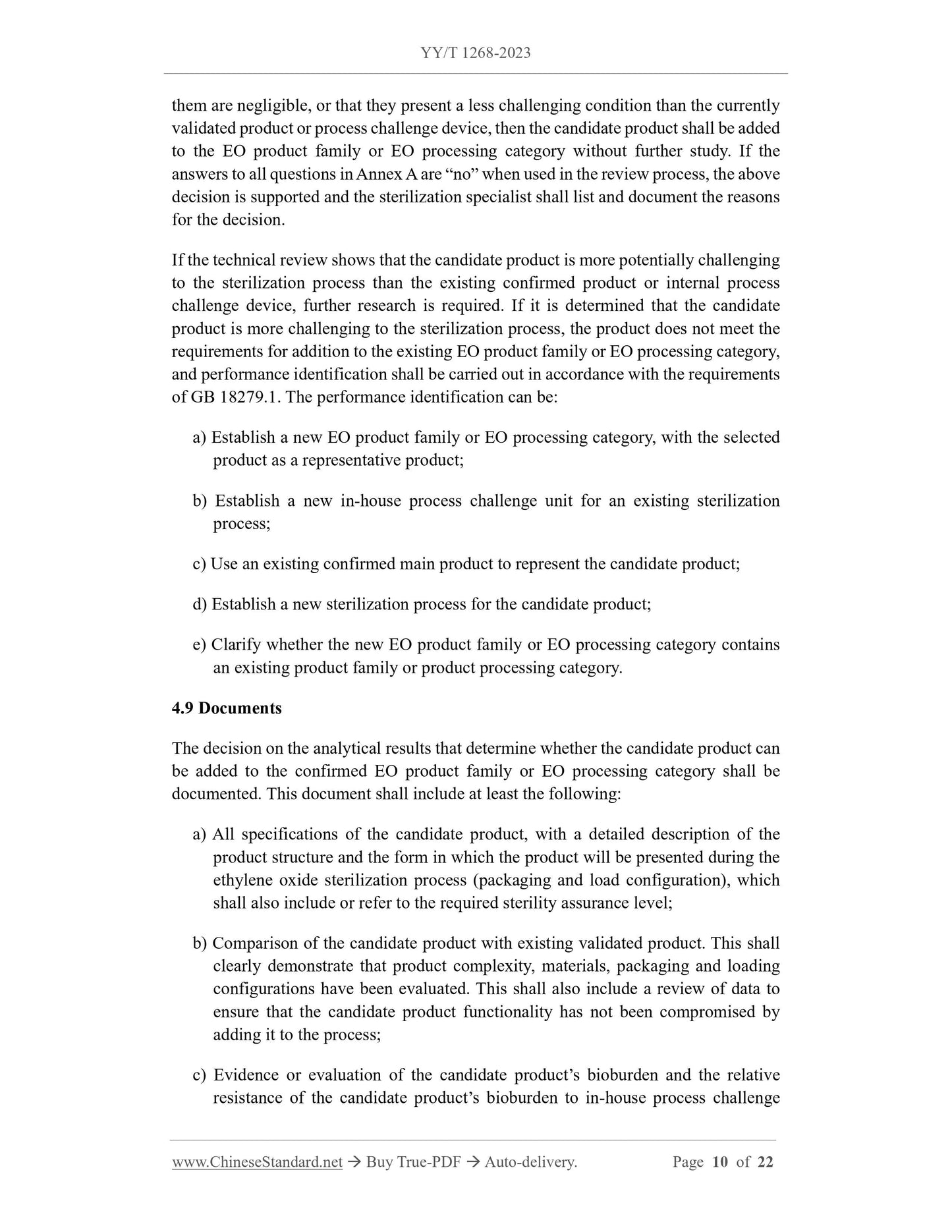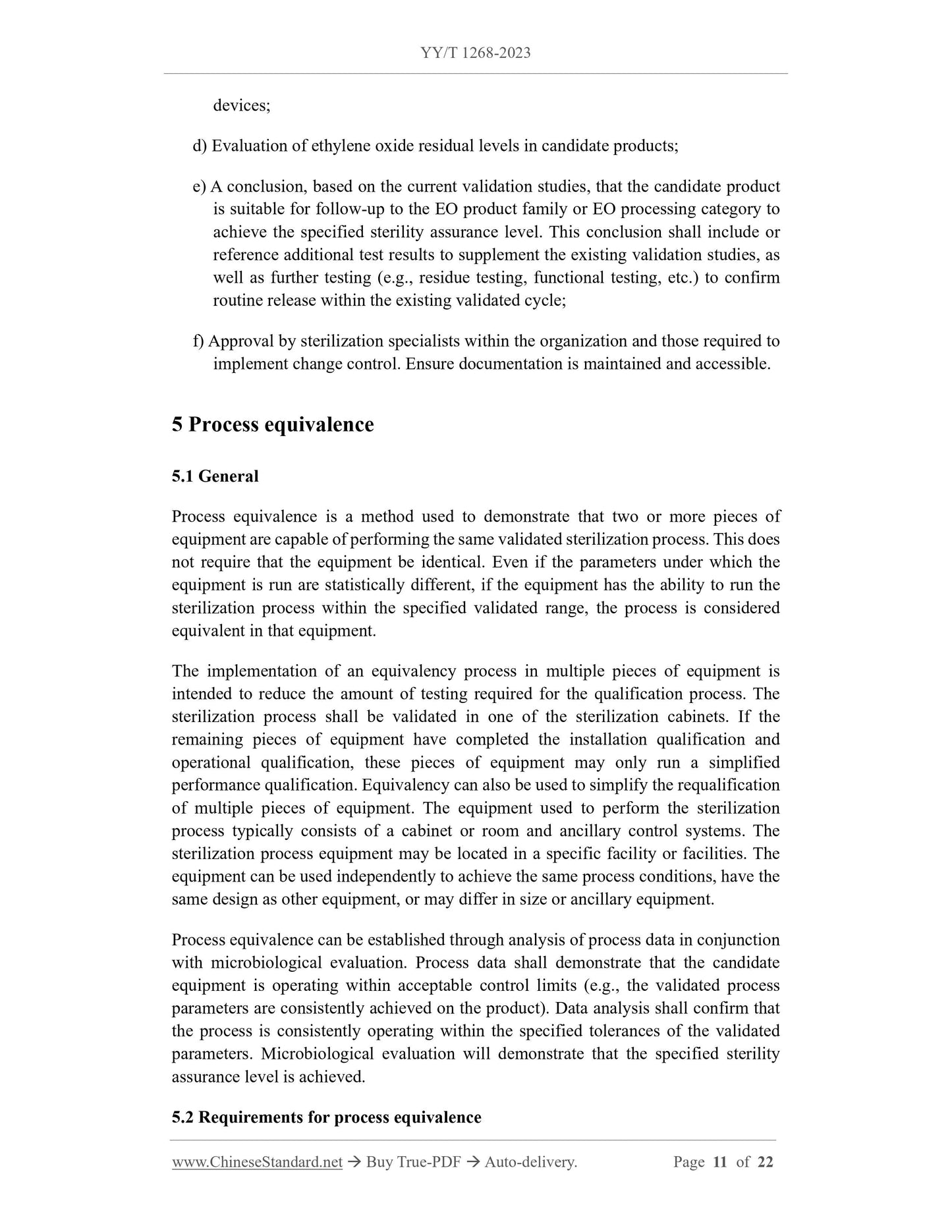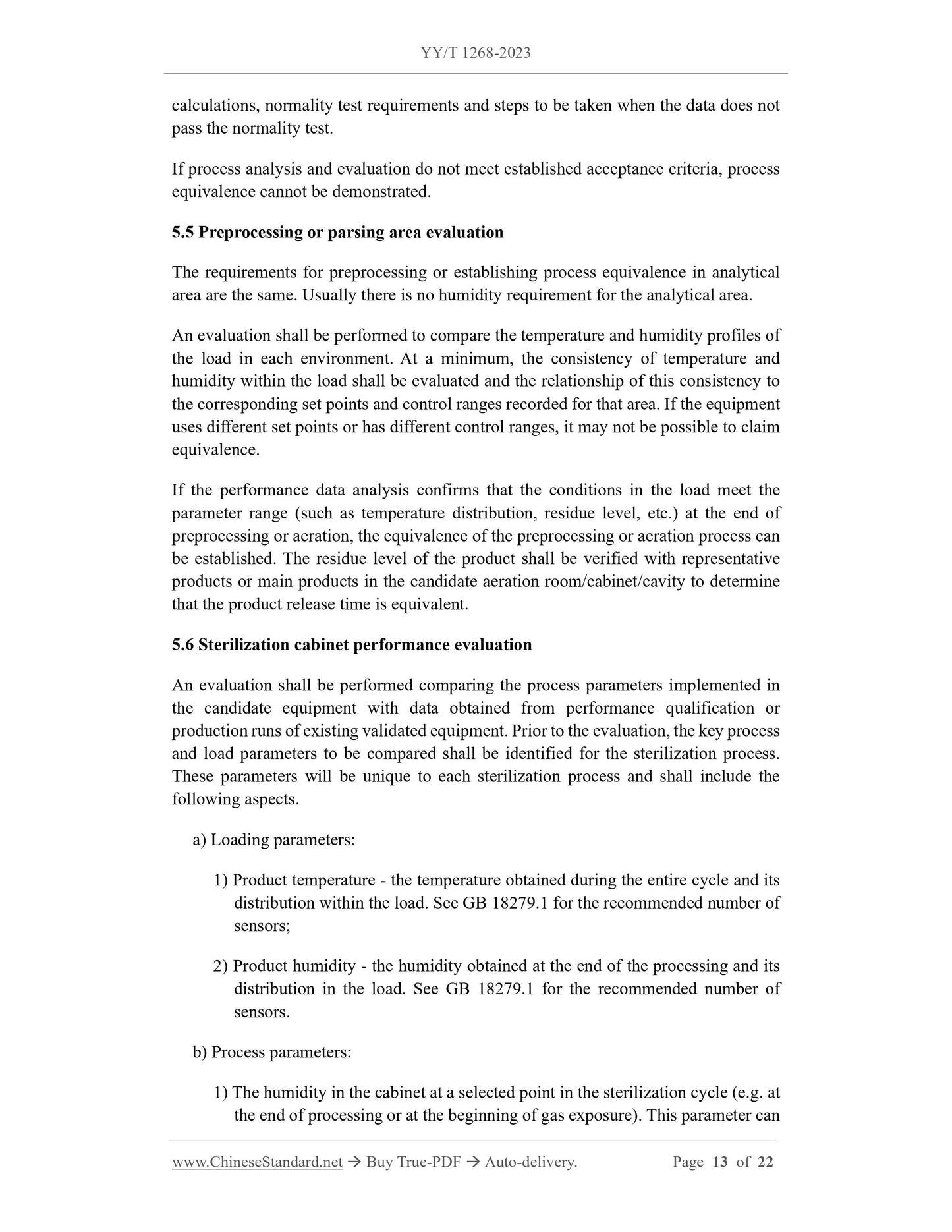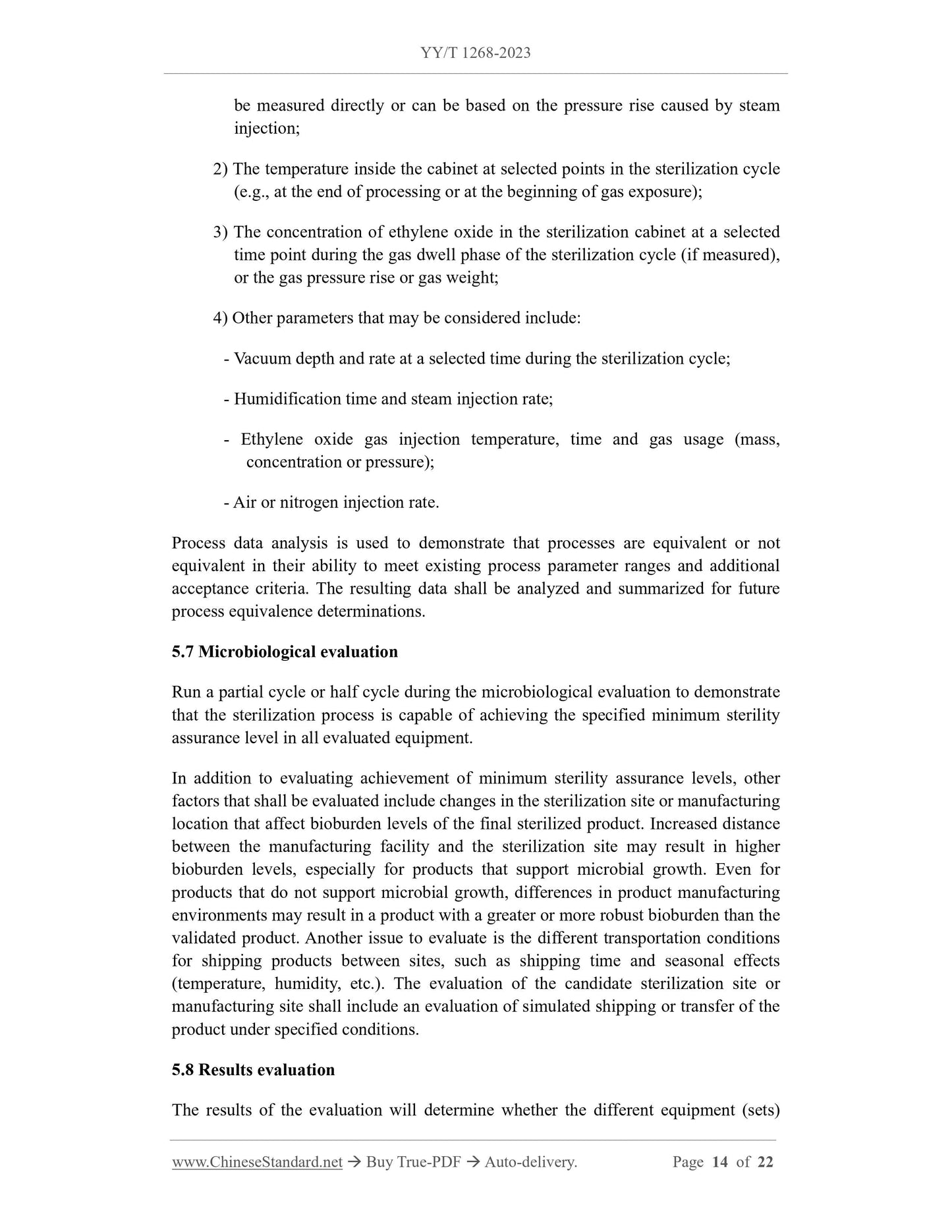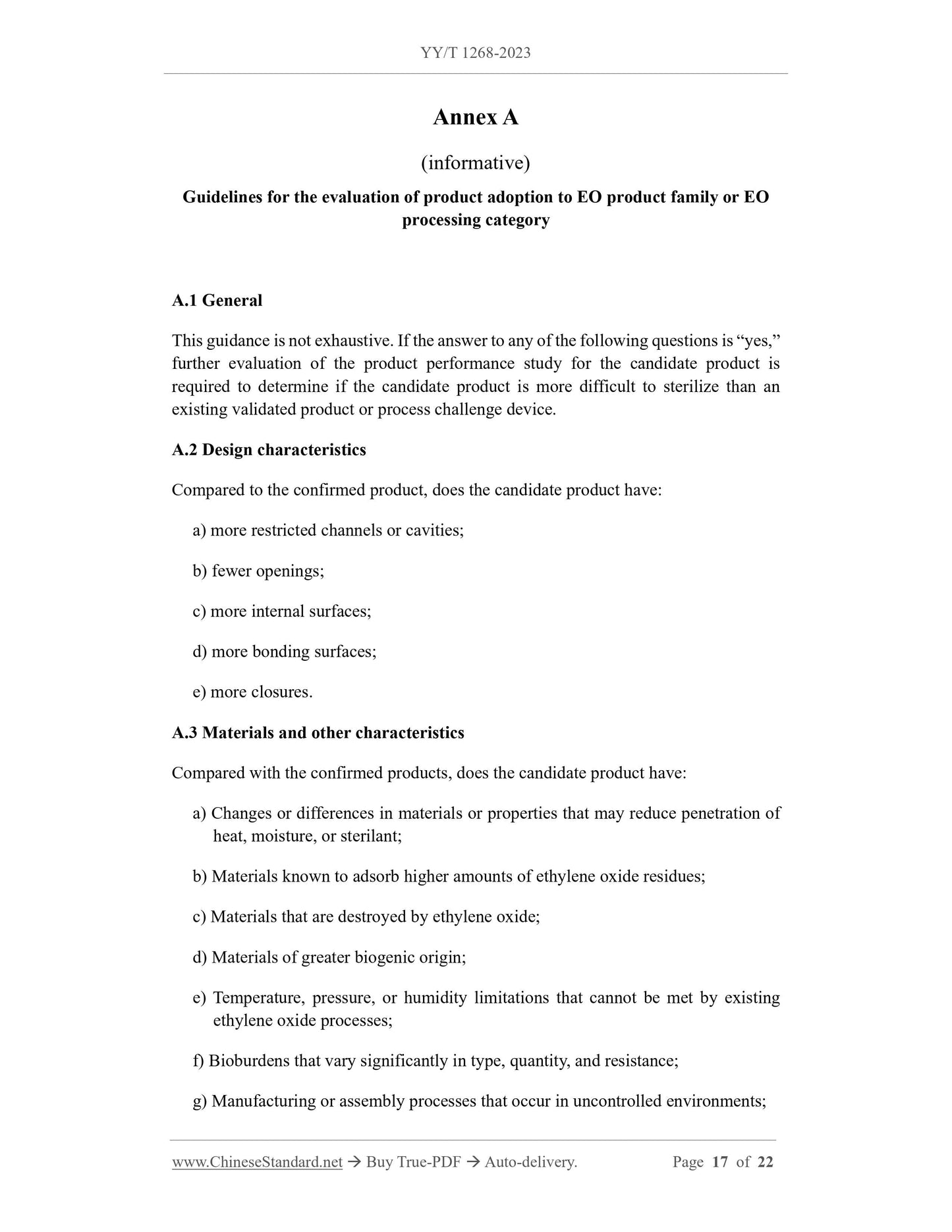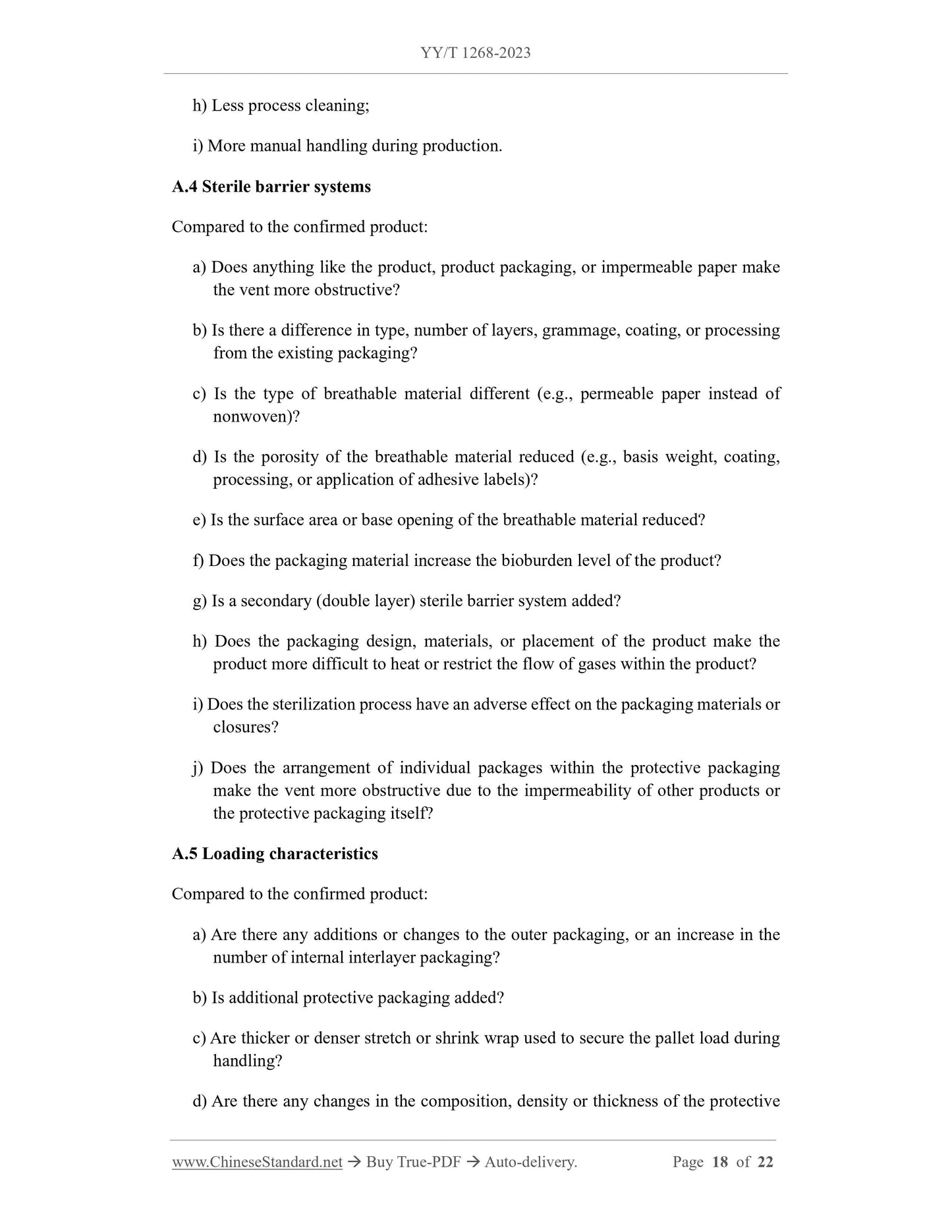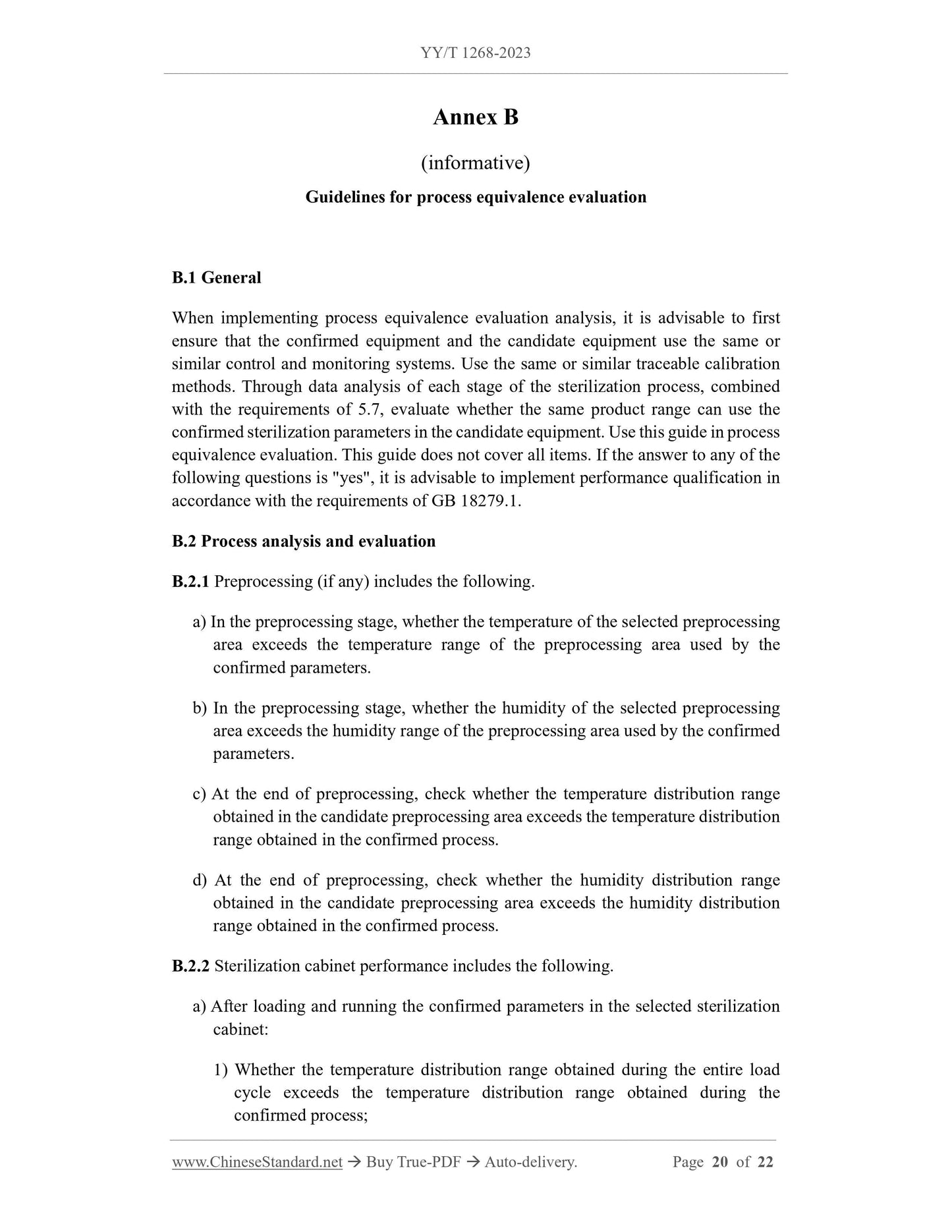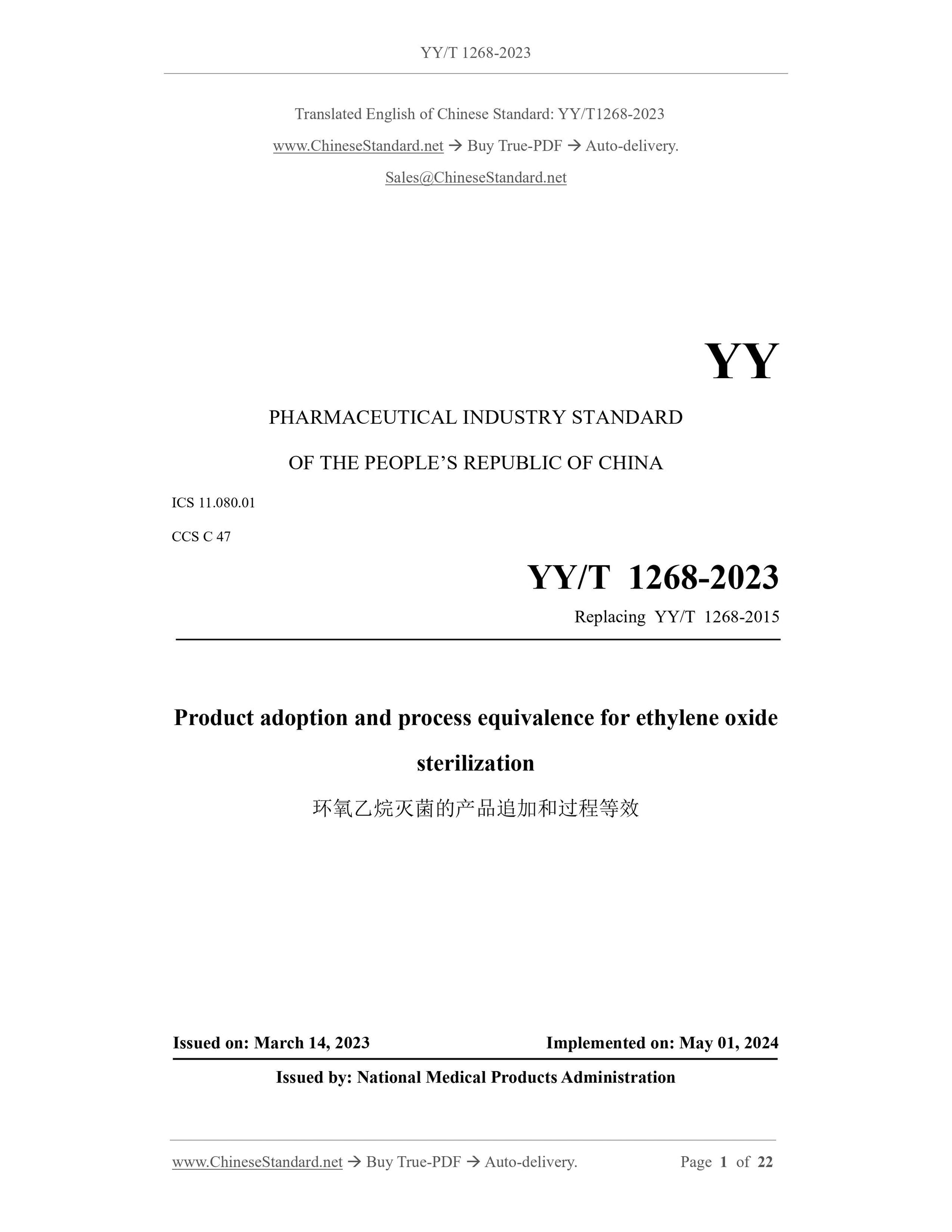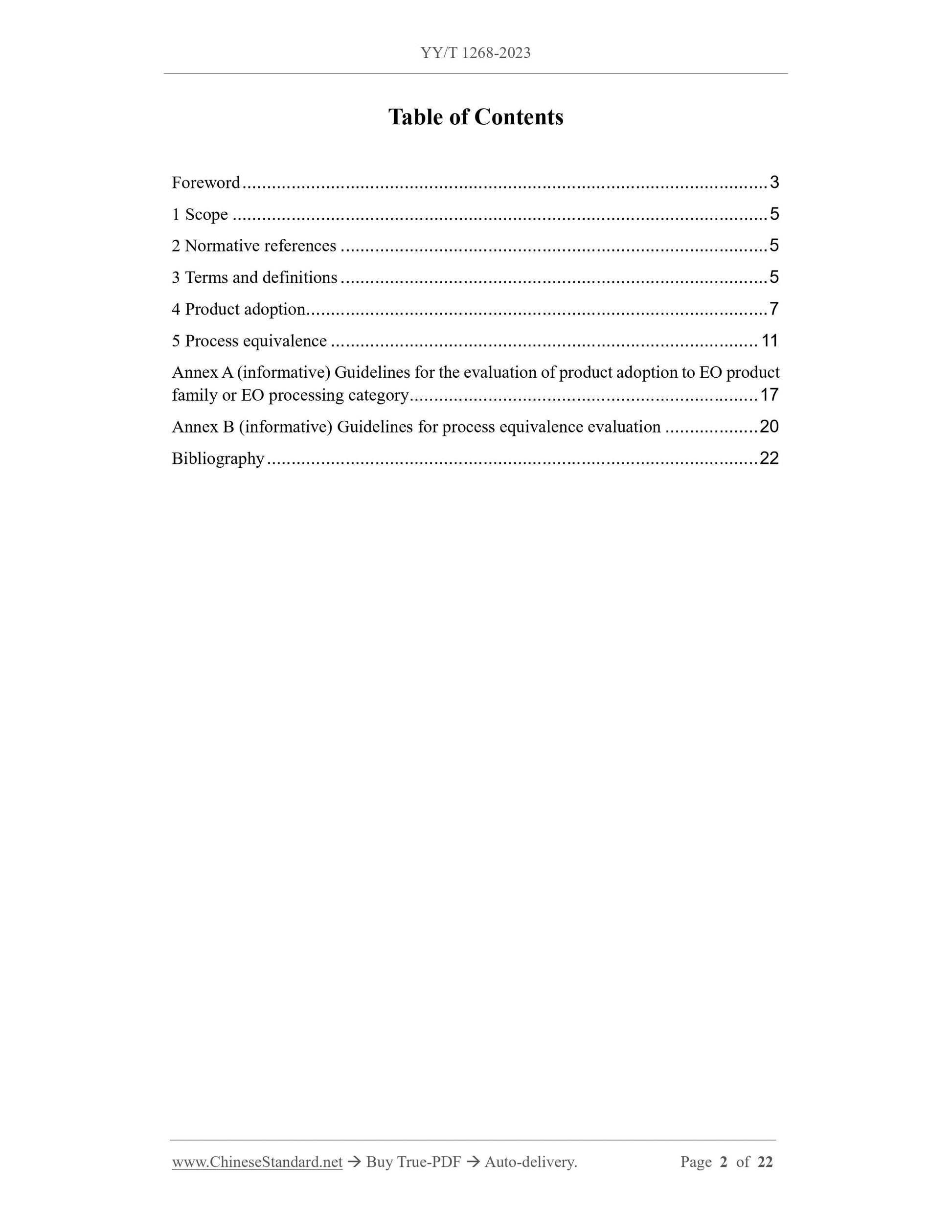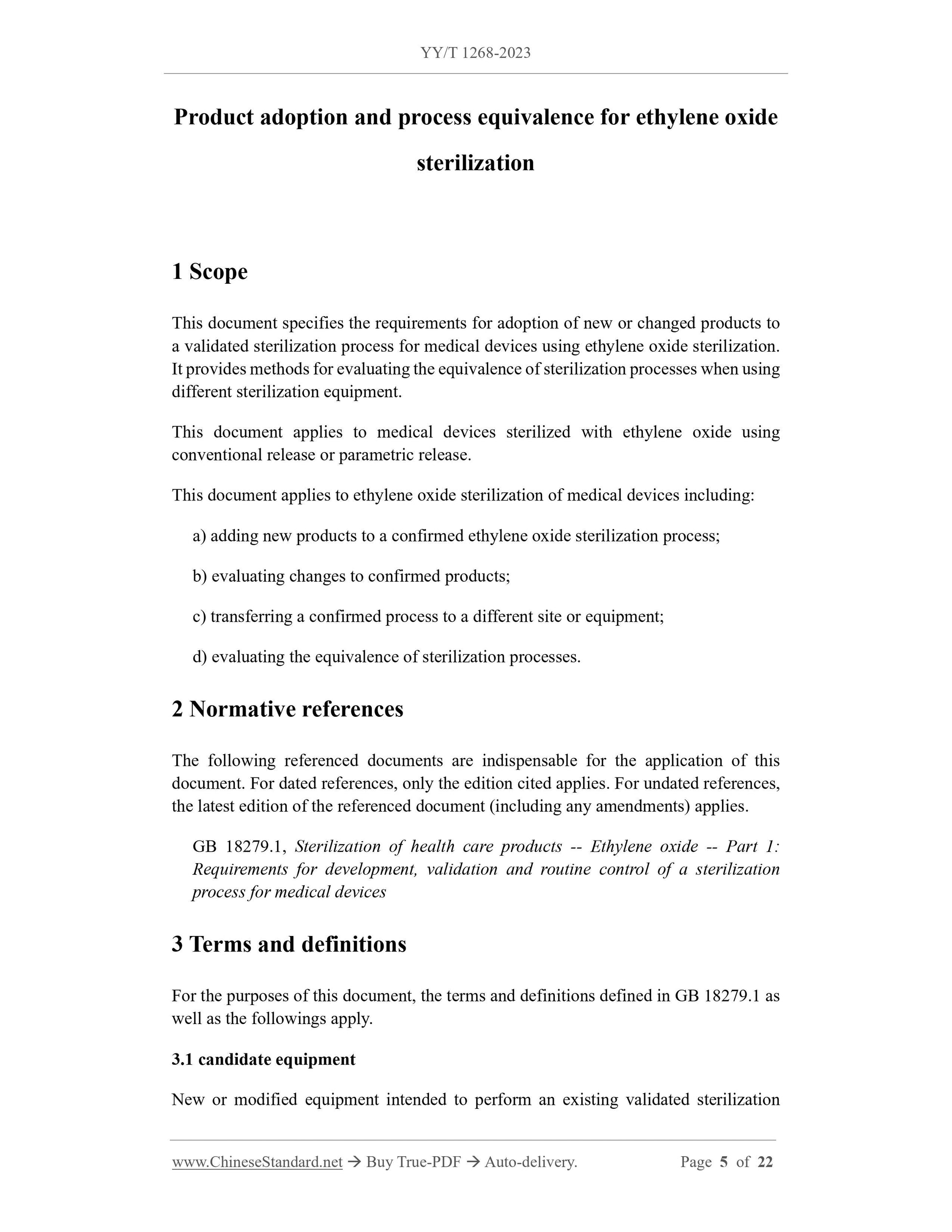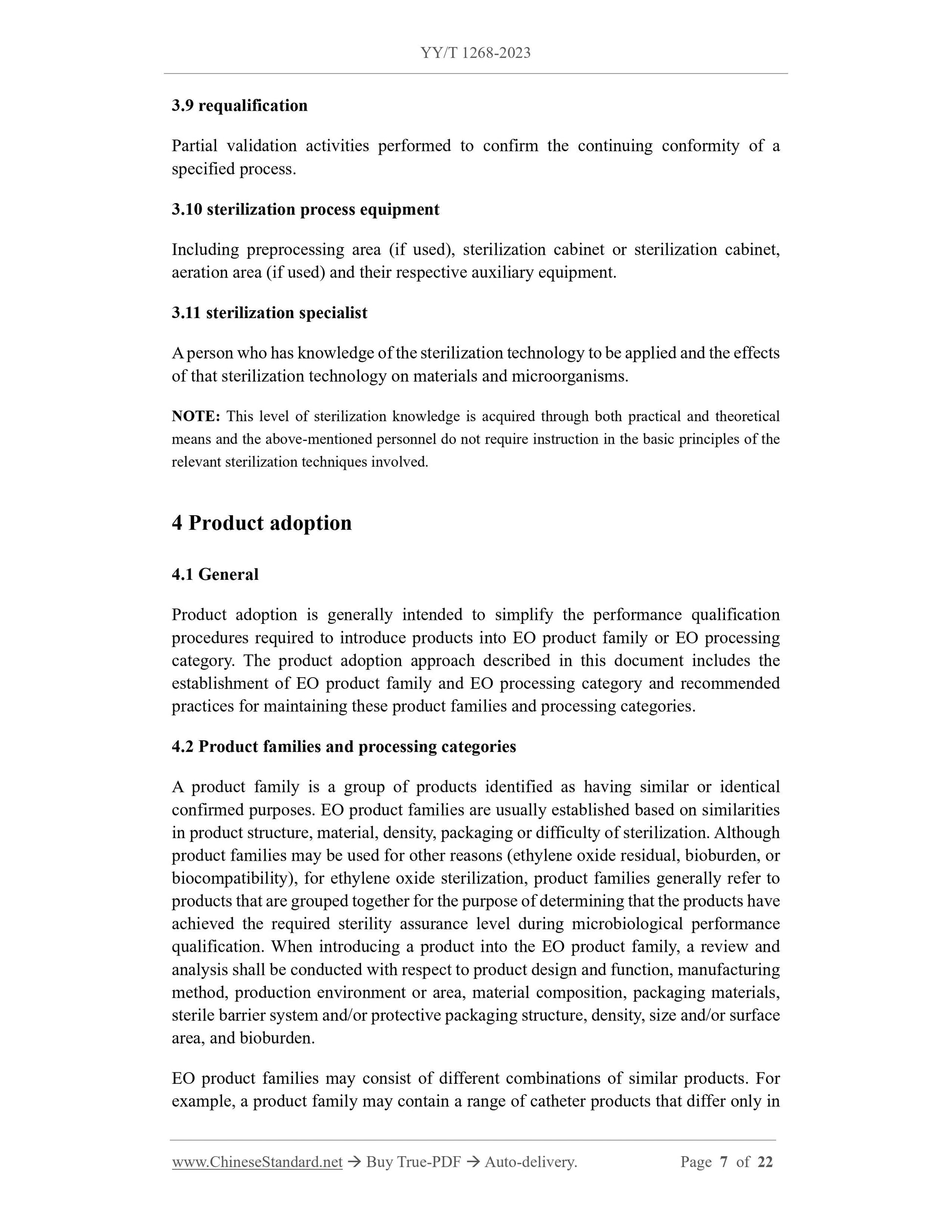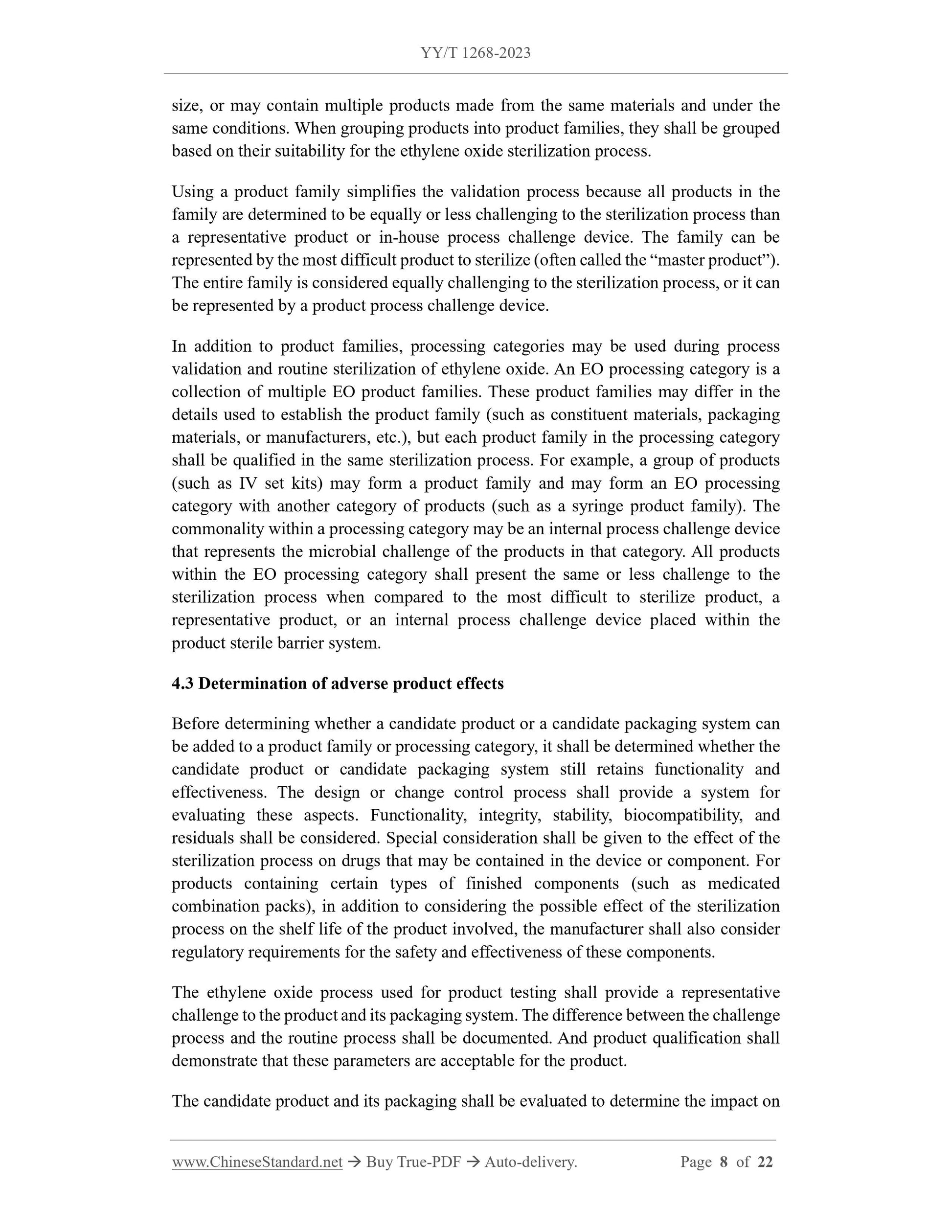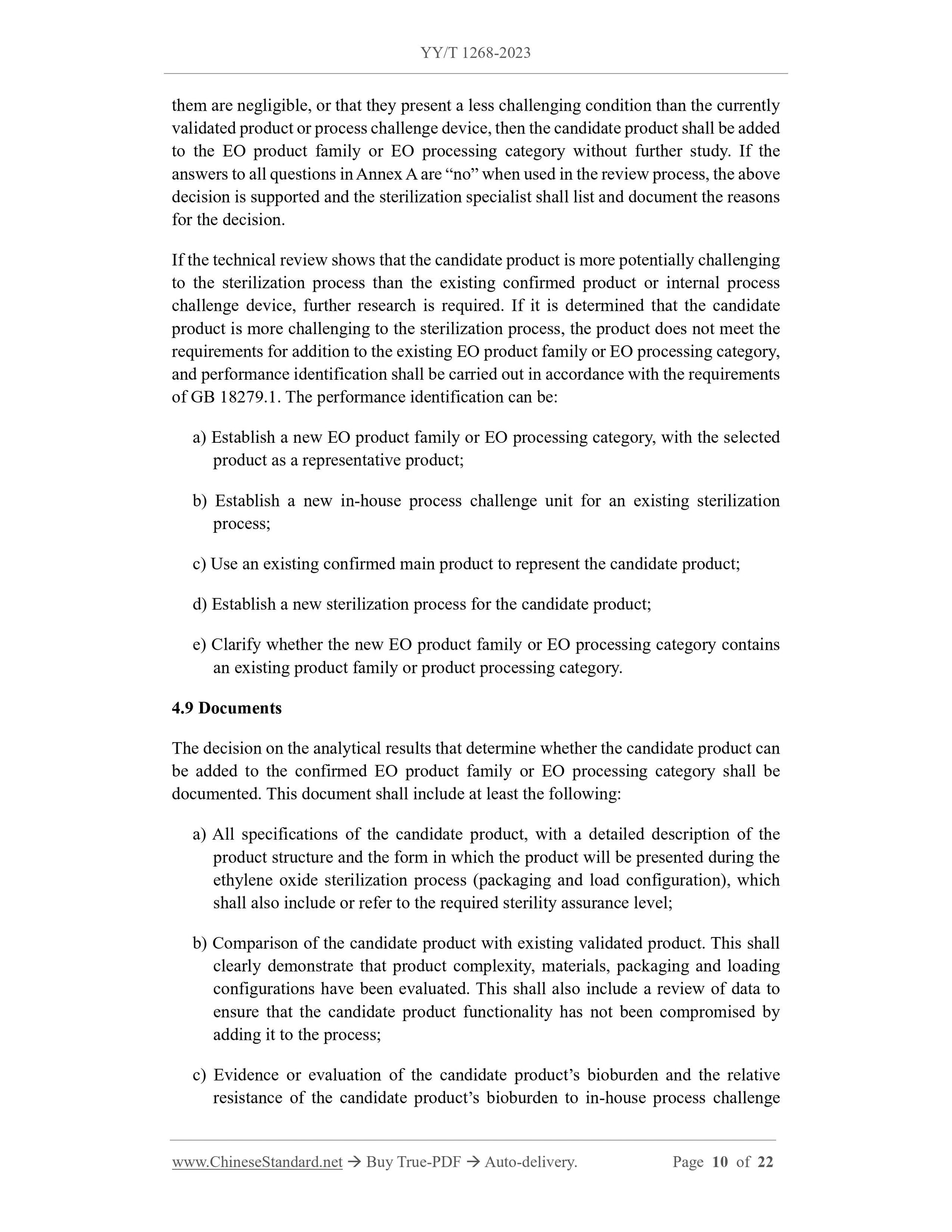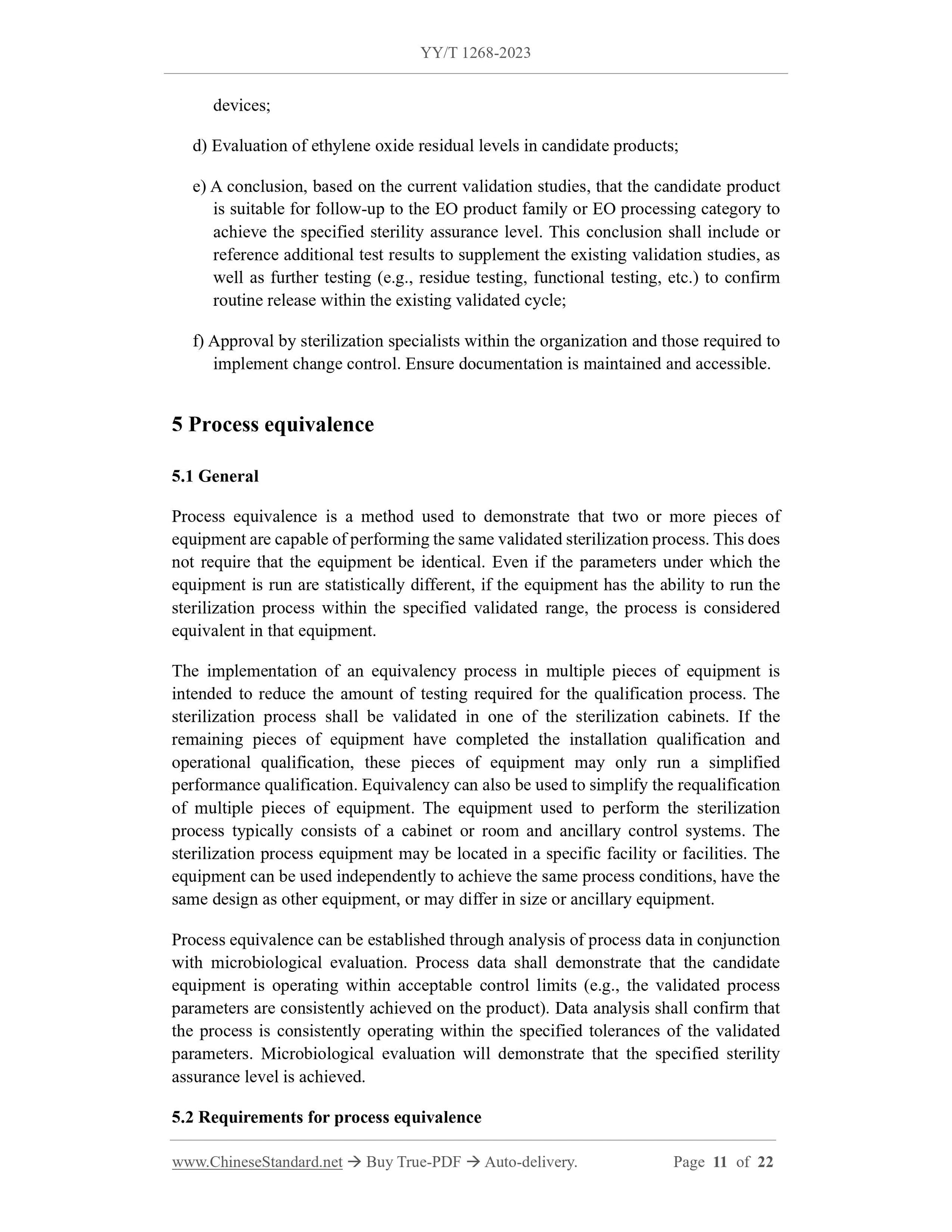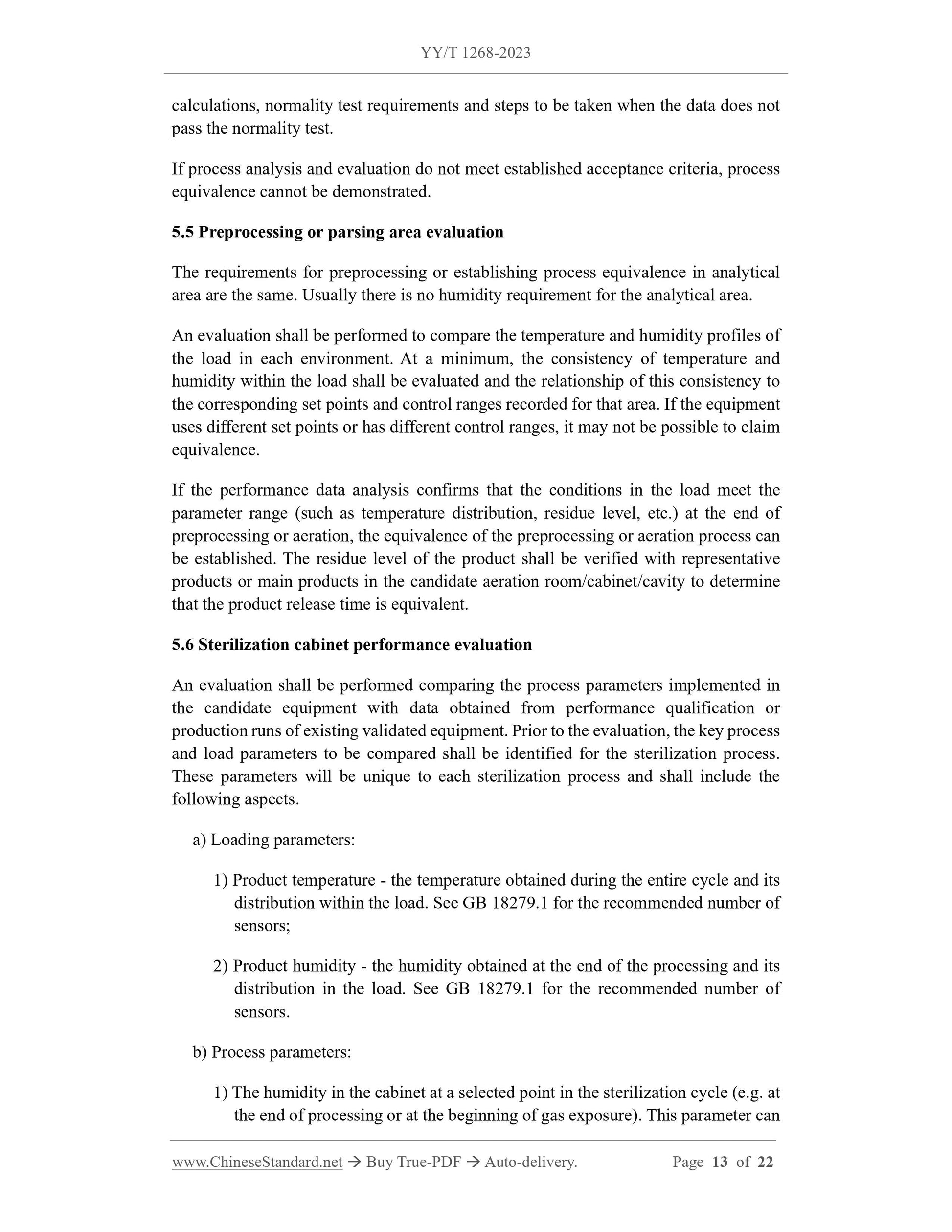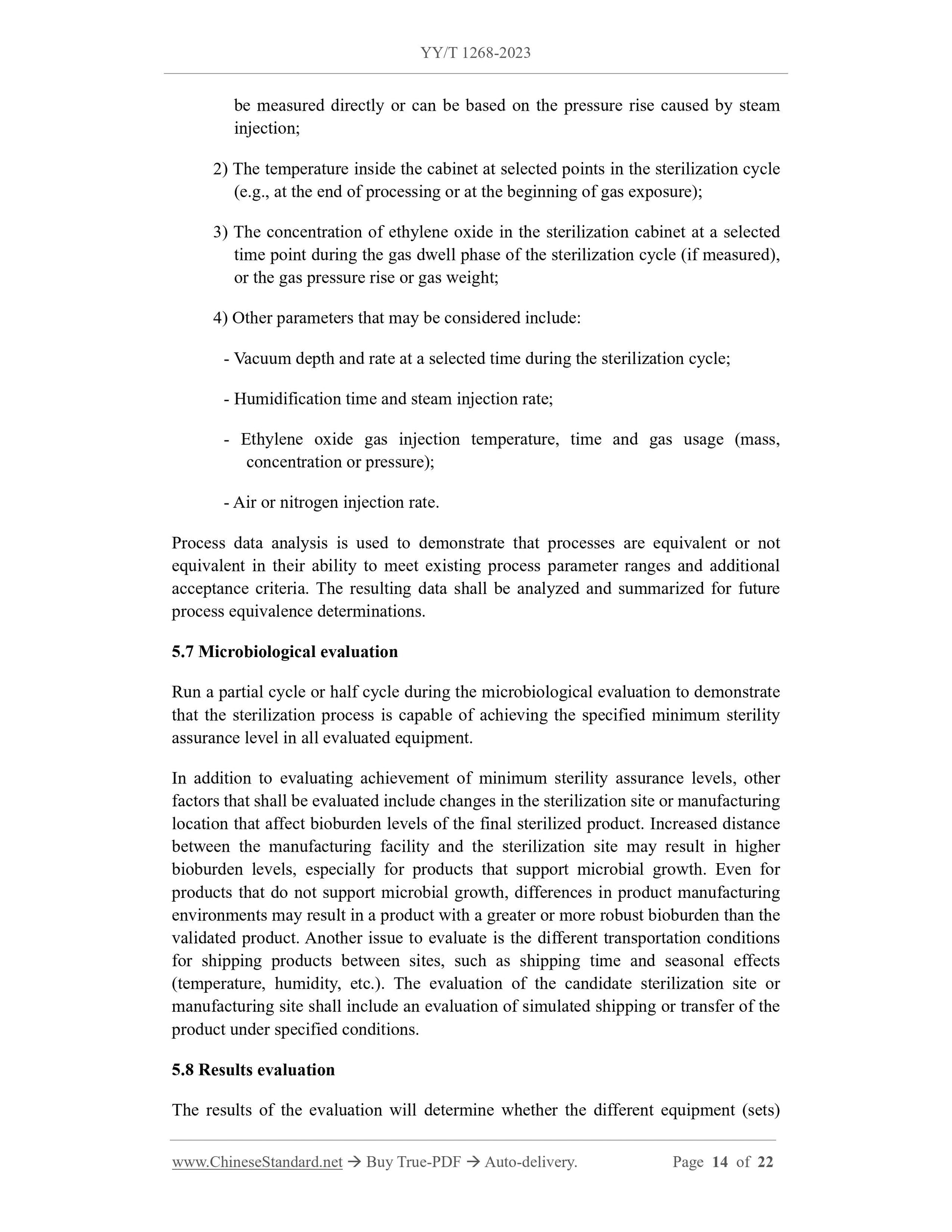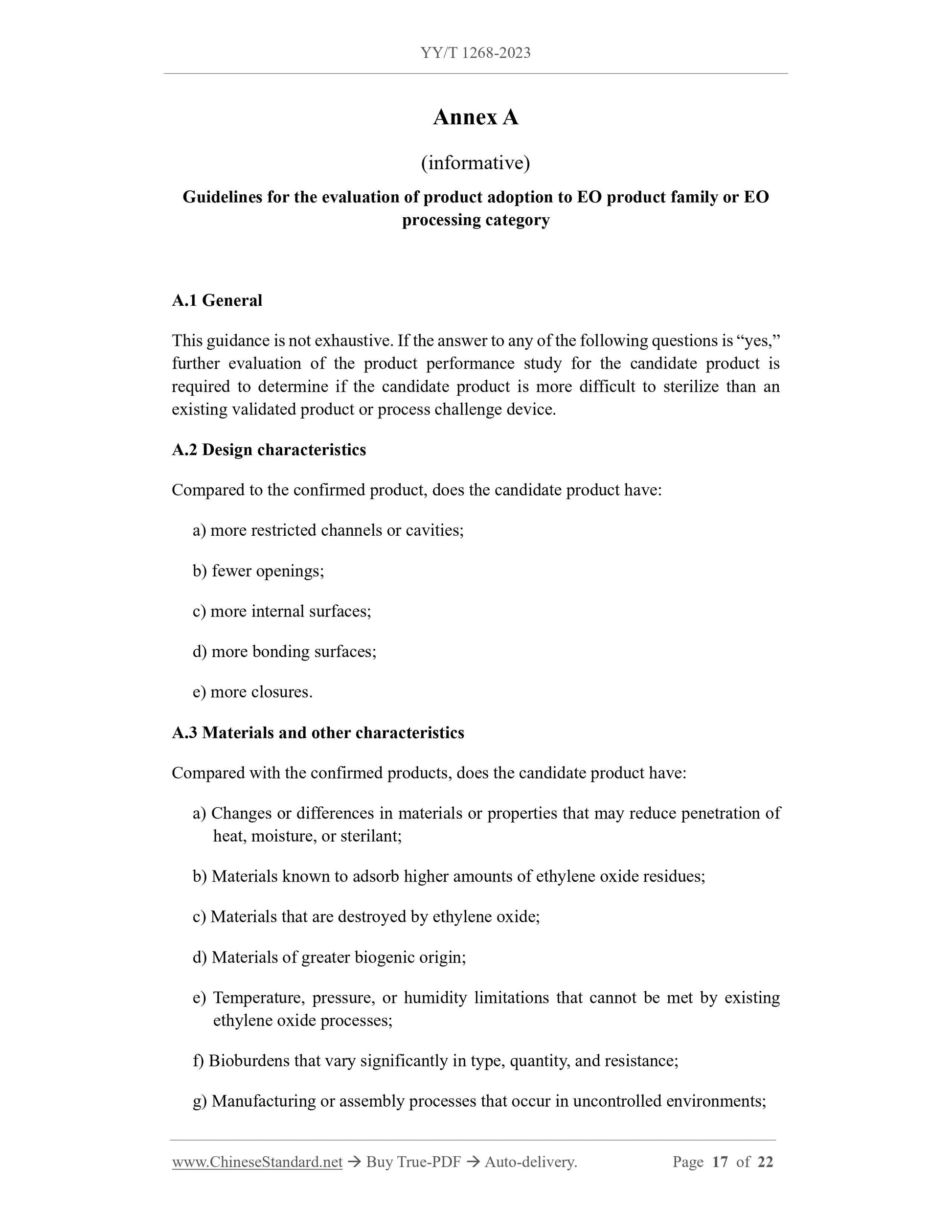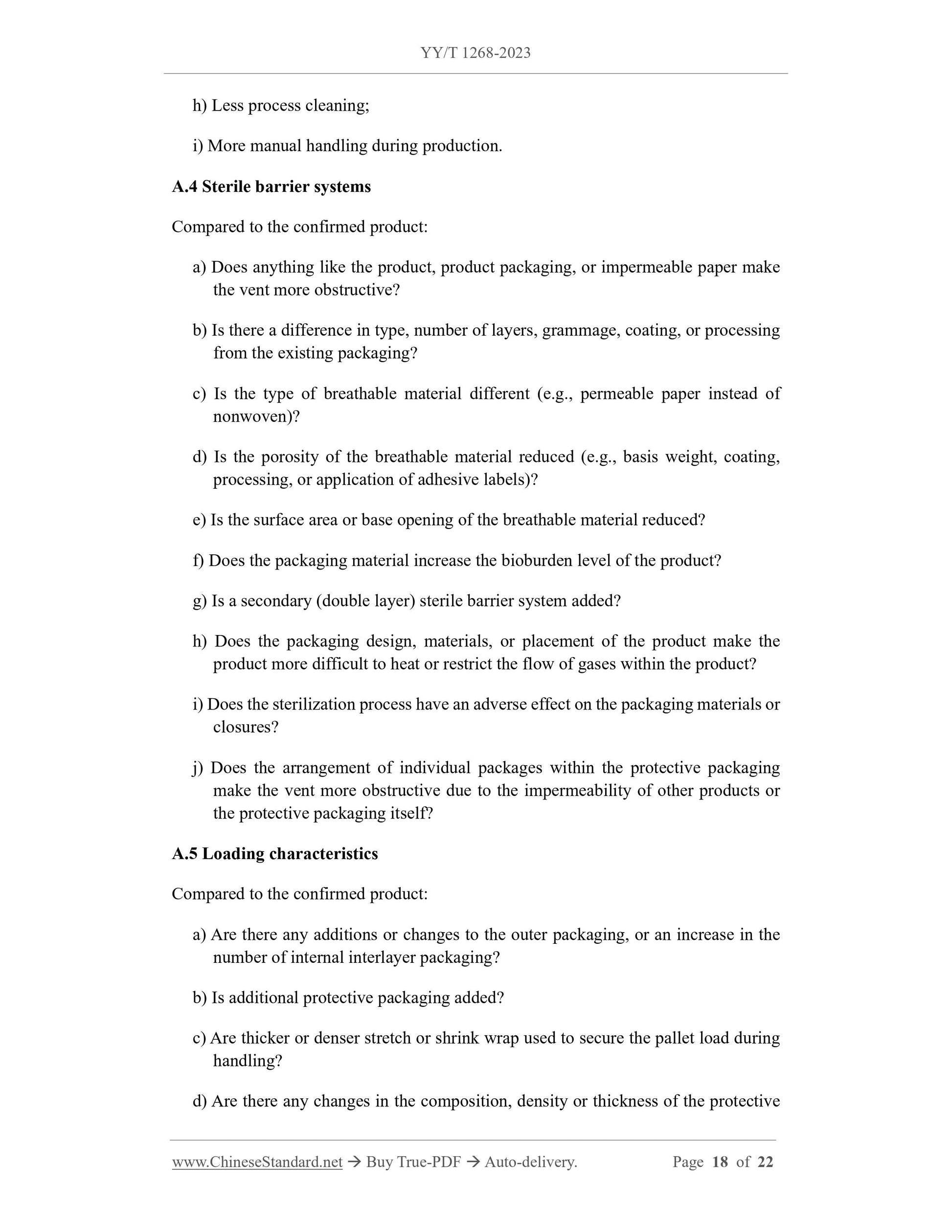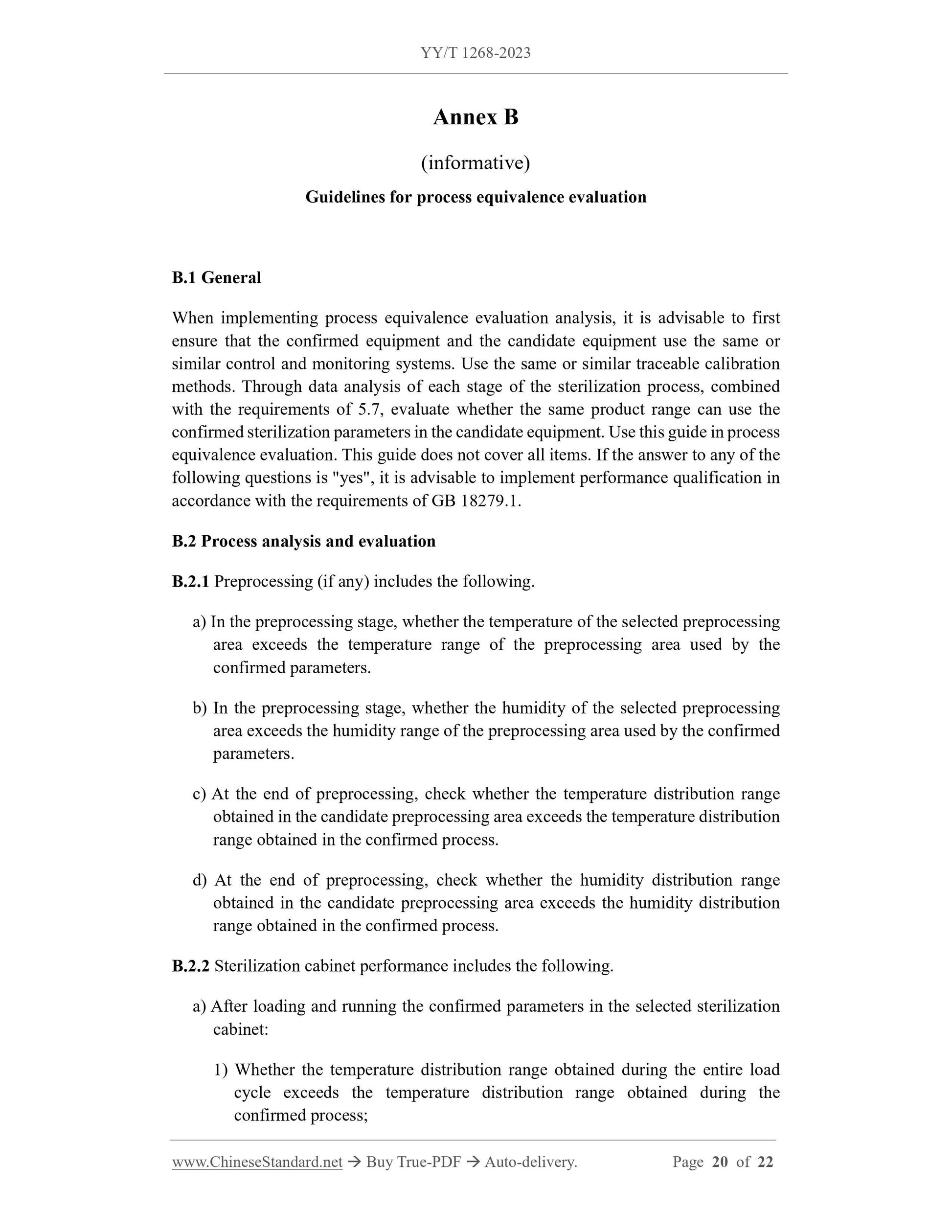1
/
of
12
PayPal, credit cards. Download editable-PDF and invoice in 1 second!
YY/T 1268-2023 English PDF (YY/T1268-2023)
YY/T 1268-2023 English PDF (YY/T1268-2023)
Regular price
$230.00 USD
Regular price
Sale price
$230.00 USD
Unit price
/
per
Shipping calculated at checkout.
Couldn't load pickup availability
Delivery: 3 seconds. Download true-PDF + Invoice.
Get Quotation: Click YY/T 1268-2023 (Self-service in 1-minute)
Historical versions (Master-website): YY/T 1268-2023
Preview True-PDF (Reload/Scroll-down if blank)
YY/T 1268-2023: Product adoption and process equivalence for ethylene oxide sterilization
YY/T 1268-2023
YY
PHARMACEUTICAL INDUSTRY STANDARD
OF THE PEOPLE’S REPUBLIC OF CHINA
ICS 11.080.01
CCS C 47
Replacing YY/T 1268-2015
Product adoption and process equivalence for ethylene oxide
sterilization
ISSUED ON: MARCH 14, 2023
IMPLEMENTED ON: MAY 01, 2024
Issued by: National Medical Products Administration
Table of Contents
Foreword ... 3
1 Scope ... 5
2 Normative references ... 5
3 Terms and definitions ... 5
4 Product adoption ... 7
5 Process equivalence ... 11
Annex A (informative) Guidelines for the evaluation of product adoption to EO product
family or EO processing category ... 17
Annex B (informative) Guidelines for process equivalence evaluation ... 20
Bibliography ... 22
Product adoption and process equivalence for ethylene oxide
sterilization
1 Scope
This document specifies the requirements for adoption of new or changed products to
a validated sterilization process for medical devices using ethylene oxide sterilization.
It provides methods for evaluating the equivalence of sterilization processes when using
different sterilization equipment.
This document applies to medical devices sterilized with ethylene oxide using
conventional release or parametric release.
This document applies to ethylene oxide sterilization of medical devices including:
a) adding new products to a confirmed ethylene oxide sterilization process;
b) evaluating changes to confirmed products;
c) transferring a confirmed process to a different site or equipment;
d) evaluating the equivalence of sterilization processes.
2 Normative references
The following referenced documents are indispensable for the application of this
document. For dated references, only the edition cited applies. For undated references,
the latest edition of the referenced document (including any amendments) applies.
GB 18279.1, Sterilization of health care products -- Ethylene oxide -- Part 1:
Requirements for development, validation and routine control of a sterilization
process for medical devices
3 Terms and definitions
For the purposes of this document, the terms and definitions defined in GB 18279.1 as
well as the followings apply.
3.1 candidate equipment
New or modified equipment intended to perform an existing validated sterilization
3.9 requalification
Partial validation activities performed to confirm the continuing conformity of a
specified process.
3.10 sterilization process equipment
Including preprocessing area (if used), sterilization cabinet or sterilization cabinet,
aeration area (if used) and their respective auxiliary equipment.
3.11 sterilization specialist
A person who has knowledge of the sterilization technology to be applied and the effects
of that sterilization technology on materials and microorganisms.
NOTE: This level of sterilization knowledge is acquired through both practical and theoretical
means and the above-mentioned personnel do not require instruction in the basic principles of the
relevant sterilization techniques involved.
4 Product adoption
4.1 General
Product adoption is generally intended to simplify the performance qualification
procedures required to introduce products into EO product family or EO processing
category. The product adoption approach described in this document includes the
establishment of EO product family and EO processing category and recommended
practices for maintaining these product families and processing categories.
4.2 Product families and processing categories
A product family is a group of products identified as having similar or identical
confirmed purposes. EO product families are usually established based on similarities
in product structure, material, density, packaging or difficulty of sterilization. Although
product families may be used for other reasons (ethylene oxide residual, bioburden, or
biocompatibility), for ethylene oxide sterilization, product families generally refer to
products that are grouped together for the purpose of determining that the products have
achieved the required sterility assurance level during microbiological performance
qualification. When introducing a product into the EO product family, a review and
analysis shall be conducted with respect to product design and function, manufacturing
method, production environment or area, material composition, packaging materials,
sterile barrier system and/or protective packaging structure, density, size and/or surface
area, and bioburden.
EO product families may consist of different combinations of similar products. For
example, a product family may contain a range of catheter products that differ only in
size, or may contain multiple products made from the same materials and under the
same conditions. When grouping products into product families, they shall be grouped
based on their suitability for the ethylene oxide sterilization process.
Using a product family simplifies the validation process because all products in the
family are determined to be equally or less challenging to the sterilization process than
a representative product or in-house process challenge device. The family can be
represented by the most difficult product to sterilize (often called the “master product”).
The entire family is considered equally challenging to the sterilization process, or it can
be represented by a product process challenge device.
In addition to product families, processing categories may be used during process
validation and routine sterilization of ethylene oxide. An EO processing category is a
collection of multiple EO product families. These product families may differ in the
details used to establish the product family (such as constituent materials, packaging
materials, or manufacturers, etc.), but each product family in the processing category
shall be qualified in the same sterilization process. For example, a group of products
(such as IV set kits) may form a product family and may form an EO processing
category with another category of products (such as a syringe product family). The
commonality within a processing category may be an internal process challenge device
that represents the microbial challenge of the products in that category. All products
within the EO processing category shall present the same or less challenge to the
sterilization process when compared to the most difficult to sterilize product, a
representative product, or an internal process challenge device placed within the
product sterile barrier system.
4.3 Determination of adverse product effects
Before determining whether a candidate product or a candidate packaging system can
be added to a product family or processing category, it shall be determined whether the
candidate product or candidate packaging system still retains functionality and
effectiveness. The design or change control process shall provide a system for
evaluating these aspects. Functionality, integrity, stability, biocompatibility, and
residuals shall be considered. Special consideration shall be given to the effect of the
sterilization process on drugs that may be contained in the device or component. For
products containing certain types of finished components (such as medicated
combination packs), in addition to considering the possible effect of the sterilization
process on the shelf life of the product involved, the manufacturer shall also consider
regulatory requirements for the safety and effectiveness of these components.
The ethylene oxide process used for product testing shall provide a representative
challenge to the product and its packaging system. The difference between the challenge
process and the routine process shall be documented. And product qualification shall
demonstrate that these parameters are acceptable for the product.
The candidate product and its packaging shall be evaluated to determine the impact on
them are negligible, or that they present a less challenging condition than the currently
validated product or process challenge device, then the candidate product shall be added
to the EO product family or EO processing category without further study. If the
answers to all questions in Annex A are “no” when used in the review process, the above
decision is supported and the sterilization specialist shall list and document the reasons
for the decision.
If the technical review shows that the candidate product is more potentially challenging
to the sterilization process than the existing confirmed product or internal process
challenge device, further research is required. If it is determined that the candidate
product is more challenging to the sterilization process, the product does not meet the
requirements for addition to the existing EO product family or EO processing category,
and performance identification shall be carried out in accordance with the requirements
of GB 18279.1. The performance identification can be:
a) Establish a new EO product family or EO processing category, with the selected
product as a representative product;
b) Establish a new in-house process challenge unit for an existing sterilization
process;
c) Use an existing confirmed main product to represent the candidate product;
d) Establish a new sterilization process for the candidate product;
e) Clarify whether the new EO product family or EO processing category contains
an existing product family or product processing category.
4.9 Documents
The decision on the analytical results that determine whether the candidate product can
be added to the confirmed EO product family or EO processing category shall be
documented. This document shall include at least the following:
a) All specifications of the candidate product, with a detailed description of the
product structure and the form in which the product will be presented during the
ethylene oxide sterilization process (packaging and load configuration), which
shall also include or refer to the required sterility assurance level;
b) Comparison of the candidate product with existing validated product. This shall
clearly demonstrate that product complexity, materials, packaging and loading
configurations have been evaluated. This shall also include a review of data to
ensure that the candidate product functionality has not been compromised by
adding it to the process;
c) Evidence or evaluation of the candidate product’s bioburden and the relative
resistance of the candidate product’s bioburden to in-house process challenge
devices;
d) Evaluation of ethylene oxide residual levels in candidate products;
e) A conclusion, based on the current validation studies, that the candidate product
is suitable for follow-up to the EO product family or EO processing category to
achieve the specified sterility assurance level. This conclusion shall include or
reference additional test results to supplement the existing validation studies, as
well as further testing (e.g., residue testing, functional testing, etc.) to confirm
routine release within the existing validated cycle;
f) Approval by sterilization specialists within the organization and those required to
implement change control. Ensure documentation is maintained and accessible.
5 Process equivalence
5.1 General
Process equivalence is a method used to demonstrate that two or more pieces of
equipment are capable of performing the same validated sterilization process. This does
not require that the equipment be identical. Even if the parameters under which the
equipment is run are statistically different, if the equipment has the ability to run the
sterilization process within the specified validated range, the process is considered
equivalent in that equipment.
The implementation of an equivalency process in multiple pieces of equipment is
intended to reduce the amount of testing required for the qualification process. The
sterilization process shall be validated in one of the sterilization cabinets. If the
remaining pieces of equipment have completed the installation qualification and
operational qualification, these pieces of equipment may only run a simplified
performance qualification. Equivalency can also be used to simplify the requalification
of multiple pieces of equipment. The equipment used to perform the sterilization
process typically consists of a cabinet or room and ancillary control systems. The
sterilization process equipment may be located in a specific facility or facilities. The
equipment can be used independently to achieve the same process conditions, have the
same design as other equipment, or may differ in size or ancillary equipment.
Process equivalence can be established through analysis of process data in conjunction
with microbiological evaluation. Process data shall demonstrate that the candidate
equipment is operating within acceptable control limits (e.g., the validated process
parameters are consistently achieved on the product). Data analysis shall confirm that
the process is consistently operating within the specified tolerances of the validated
parameters. Microbiological evaluation will demonstrate that the specified sterility
assurance level is achieved.
5.2 Requirements for process equivalence
calculations, normality test requirements and steps to be taken when the data does not
pass the normality test.
If process analysis and evaluation do not meet established acceptance criteria, process
equivalence cannot be demonstrated.
5.5 Preprocessing or parsing area evaluation
The requirements for preprocessing or establishing process equivalence in analytical
area are the same. Usually there is no humidity requirement for the analytical area.
An evaluation shall be performed to compare the temperature and humidity profiles of
the load in each environment. At a minimum, the consistency of temperature and
humidity within the load shall be evaluated and the relationship of this consistency to
the corresponding set points and control ranges recorded for that area. If the equipment
uses different set points or has different control ranges, it...
Get Quotation: Click YY/T 1268-2023 (Self-service in 1-minute)
Historical versions (Master-website): YY/T 1268-2023
Preview True-PDF (Reload/Scroll-down if blank)
YY/T 1268-2023: Product adoption and process equivalence for ethylene oxide sterilization
YY/T 1268-2023
YY
PHARMACEUTICAL INDUSTRY STANDARD
OF THE PEOPLE’S REPUBLIC OF CHINA
ICS 11.080.01
CCS C 47
Replacing YY/T 1268-2015
Product adoption and process equivalence for ethylene oxide
sterilization
ISSUED ON: MARCH 14, 2023
IMPLEMENTED ON: MAY 01, 2024
Issued by: National Medical Products Administration
Table of Contents
Foreword ... 3
1 Scope ... 5
2 Normative references ... 5
3 Terms and definitions ... 5
4 Product adoption ... 7
5 Process equivalence ... 11
Annex A (informative) Guidelines for the evaluation of product adoption to EO product
family or EO processing category ... 17
Annex B (informative) Guidelines for process equivalence evaluation ... 20
Bibliography ... 22
Product adoption and process equivalence for ethylene oxide
sterilization
1 Scope
This document specifies the requirements for adoption of new or changed products to
a validated sterilization process for medical devices using ethylene oxide sterilization.
It provides methods for evaluating the equivalence of sterilization processes when using
different sterilization equipment.
This document applies to medical devices sterilized with ethylene oxide using
conventional release or parametric release.
This document applies to ethylene oxide sterilization of medical devices including:
a) adding new products to a confirmed ethylene oxide sterilization process;
b) evaluating changes to confirmed products;
c) transferring a confirmed process to a different site or equipment;
d) evaluating the equivalence of sterilization processes.
2 Normative references
The following referenced documents are indispensable for the application of this
document. For dated references, only the edition cited applies. For undated references,
the latest edition of the referenced document (including any amendments) applies.
GB 18279.1, Sterilization of health care products -- Ethylene oxide -- Part 1:
Requirements for development, validation and routine control of a sterilization
process for medical devices
3 Terms and definitions
For the purposes of this document, the terms and definitions defined in GB 18279.1 as
well as the followings apply.
3.1 candidate equipment
New or modified equipment intended to perform an existing validated sterilization
3.9 requalification
Partial validation activities performed to confirm the continuing conformity of a
specified process.
3.10 sterilization process equipment
Including preprocessing area (if used), sterilization cabinet or sterilization cabinet,
aeration area (if used) and their respective auxiliary equipment.
3.11 sterilization specialist
A person who has knowledge of the sterilization technology to be applied and the effects
of that sterilization technology on materials and microorganisms.
NOTE: This level of sterilization knowledge is acquired through both practical and theoretical
means and the above-mentioned personnel do not require instruction in the basic principles of the
relevant sterilization techniques involved.
4 Product adoption
4.1 General
Product adoption is generally intended to simplify the performance qualification
procedures required to introduce products into EO product family or EO processing
category. The product adoption approach described in this document includes the
establishment of EO product family and EO processing category and recommended
practices for maintaining these product families and processing categories.
4.2 Product families and processing categories
A product family is a group of products identified as having similar or identical
confirmed purposes. EO product families are usually established based on similarities
in product structure, material, density, packaging or difficulty of sterilization. Although
product families may be used for other reasons (ethylene oxide residual, bioburden, or
biocompatibility), for ethylene oxide sterilization, product families generally refer to
products that are grouped together for the purpose of determining that the products have
achieved the required sterility assurance level during microbiological performance
qualification. When introducing a product into the EO product family, a review and
analysis shall be conducted with respect to product design and function, manufacturing
method, production environment or area, material composition, packaging materials,
sterile barrier system and/or protective packaging structure, density, size and/or surface
area, and bioburden.
EO product families may consist of different combinations of similar products. For
example, a product family may contain a range of catheter products that differ only in
size, or may contain multiple products made from the same materials and under the
same conditions. When grouping products into product families, they shall be grouped
based on their suitability for the ethylene oxide sterilization process.
Using a product family simplifies the validation process because all products in the
family are determined to be equally or less challenging to the sterilization process than
a representative product or in-house process challenge device. The family can be
represented by the most difficult product to sterilize (often called the “master product”).
The entire family is considered equally challenging to the sterilization process, or it can
be represented by a product process challenge device.
In addition to product families, processing categories may be used during process
validation and routine sterilization of ethylene oxide. An EO processing category is a
collection of multiple EO product families. These product families may differ in the
details used to establish the product family (such as constituent materials, packaging
materials, or manufacturers, etc.), but each product family in the processing category
shall be qualified in the same sterilization process. For example, a group of products
(such as IV set kits) may form a product family and may form an EO processing
category with another category of products (such as a syringe product family). The
commonality within a processing category may be an internal process challenge device
that represents the microbial challenge of the products in that category. All products
within the EO processing category shall present the same or less challenge to the
sterilization process when compared to the most difficult to sterilize product, a
representative product, or an internal process challenge device placed within the
product sterile barrier system.
4.3 Determination of adverse product effects
Before determining whether a candidate product or a candidate packaging system can
be added to a product family or processing category, it shall be determined whether the
candidate product or candidate packaging system still retains functionality and
effectiveness. The design or change control process shall provide a system for
evaluating these aspects. Functionality, integrity, stability, biocompatibility, and
residuals shall be considered. Special consideration shall be given to the effect of the
sterilization process on drugs that may be contained in the device or component. For
products containing certain types of finished components (such as medicated
combination packs), in addition to considering the possible effect of the sterilization
process on the shelf life of the product involved, the manufacturer shall also consider
regulatory requirements for the safety and effectiveness of these components.
The ethylene oxide process used for product testing shall provide a representative
challenge to the product and its packaging system. The difference between the challenge
process and the routine process shall be documented. And product qualification shall
demonstrate that these parameters are acceptable for the product.
The candidate product and its packaging shall be evaluated to determine the impact on
them are negligible, or that they present a less challenging condition than the currently
validated product or process challenge device, then the candidate product shall be added
to the EO product family or EO processing category without further study. If the
answers to all questions in Annex A are “no” when used in the review process, the above
decision is supported and the sterilization specialist shall list and document the reasons
for the decision.
If the technical review shows that the candidate product is more potentially challenging
to the sterilization process than the existing confirmed product or internal process
challenge device, further research is required. If it is determined that the candidate
product is more challenging to the sterilization process, the product does not meet the
requirements for addition to the existing EO product family or EO processing category,
and performance identification shall be carried out in accordance with the requirements
of GB 18279.1. The performance identification can be:
a) Establish a new EO product family or EO processing category, with the selected
product as a representative product;
b) Establish a new in-house process challenge unit for an existing sterilization
process;
c) Use an existing confirmed main product to represent the candidate product;
d) Establish a new sterilization process for the candidate product;
e) Clarify whether the new EO product family or EO processing category contains
an existing product family or product processing category.
4.9 Documents
The decision on the analytical results that determine whether the candidate product can
be added to the confirmed EO product family or EO processing category shall be
documented. This document shall include at least the following:
a) All specifications of the candidate product, with a detailed description of the
product structure and the form in which the product will be presented during the
ethylene oxide sterilization process (packaging and load configuration), which
shall also include or refer to the required sterility assurance level;
b) Comparison of the candidate product with existing validated product. This shall
clearly demonstrate that product complexity, materials, packaging and loading
configurations have been evaluated. This shall also include a review of data to
ensure that the candidate product functionality has not been compromised by
adding it to the process;
c) Evidence or evaluation of the candidate product’s bioburden and the relative
resistance of the candidate product’s bioburden to in-house process challenge
devices;
d) Evaluation of ethylene oxide residual levels in candidate products;
e) A conclusion, based on the current validation studies, that the candidate product
is suitable for follow-up to the EO product family or EO processing category to
achieve the specified sterility assurance level. This conclusion shall include or
reference additional test results to supplement the existing validation studies, as
well as further testing (e.g., residue testing, functional testing, etc.) to confirm
routine release within the existing validated cycle;
f) Approval by sterilization specialists within the organization and those required to
implement change control. Ensure documentation is maintained and accessible.
5 Process equivalence
5.1 General
Process equivalence is a method used to demonstrate that two or more pieces of
equipment are capable of performing the same validated sterilization process. This does
not require that the equipment be identical. Even if the parameters under which the
equipment is run are statistically different, if the equipment has the ability to run the
sterilization process within the specified validated range, the process is considered
equivalent in that equipment.
The implementation of an equivalency process in multiple pieces of equipment is
intended to reduce the amount of testing required for the qualification process. The
sterilization process shall be validated in one of the sterilization cabinets. If the
remaining pieces of equipment have completed the installation qualification and
operational qualification, these pieces of equipment may only run a simplified
performance qualification. Equivalency can also be used to simplify the requalification
of multiple pieces of equipment. The equipment used to perform the sterilization
process typically consists of a cabinet or room and ancillary control systems. The
sterilization process equipment may be located in a specific facility or facilities. The
equipment can be used independently to achieve the same process conditions, have the
same design as other equipment, or may differ in size or ancillary equipment.
Process equivalence can be established through analysis of process data in conjunction
with microbiological evaluation. Process data shall demonstrate that the candidate
equipment is operating within acceptable control limits (e.g., the validated process
parameters are consistently achieved on the product). Data analysis shall confirm that
the process is consistently operating within the specified tolerances of the validated
parameters. Microbiological evaluation will demonstrate that the specified sterility
assurance level is achieved.
5.2 Requirements for process equivalence
calculations, normality test requirements and steps to be taken when the data does not
pass the normality test.
If process analysis and evaluation do not meet established acceptance criteria, process
equivalence cannot be demonstrated.
5.5 Preprocessing or parsing area evaluation
The requirements for preprocessing or establishing process equivalence in analytical
area are the same. Usually there is no humidity requirement for the analytical area.
An evaluation shall be performed to compare the temperature and humidity profiles of
the load in each environment. At a minimum, the consistency of temperature and
humidity within the load shall be evaluated and the relationship of this consistency to
the corresponding set points and control ranges recorded for that area. If the equipment
uses different set points or has different control ranges, it...
Share
